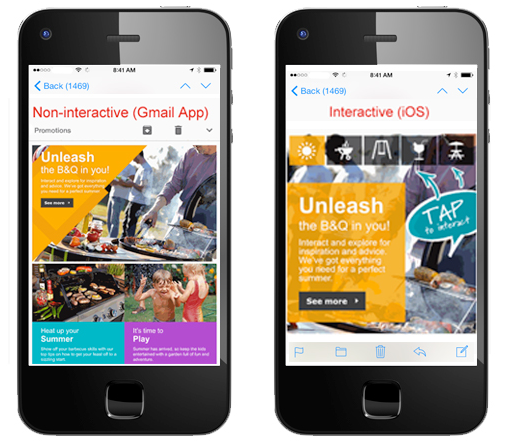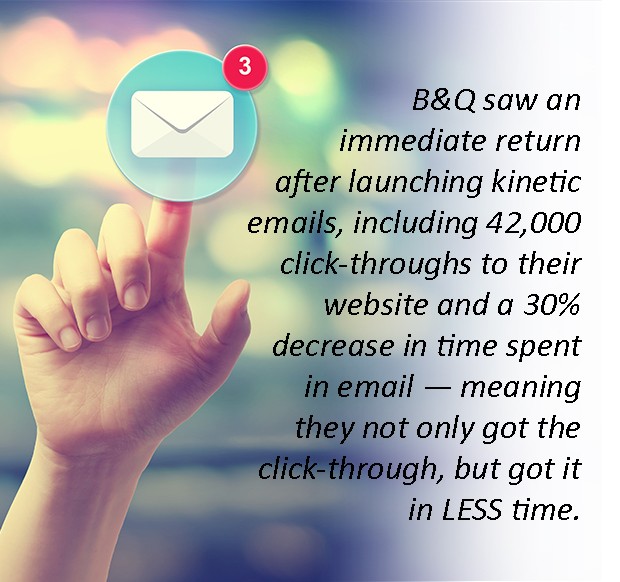Itâs Time to Meet the Latest in Dynamic Content: Kinetic Email
03 Jun 2016

The last 10 years have been a whirlwind of technological advances that have changed the way we think about marketing — almost on a daily basis. When I first started in the industry, flash-based websites were the shiny new object in play to demonstrate that your company was new and innovative. Now, we’re all about dynamic content, 1:1 marketing, and smart data — all being merged into communications via a smart phone. According to Strategy Analytics, by 2020, it’s estimated that every household will have 4.3 devices. And it’s up to us as marketers to keep up with how to creatively engage and communicate to our audience on all of them! Challenge accepted.
With that said, there’s a new type of email engagement floating around that I just can’t get out of my mind — it’s called kinetic email. What is it exactly? Well to us non-developer types, it’s a mini microsite that lives in the body of an email and creates a click-through, interactive experience by housing its own navigation. Confused? I was too. So, here’s what I’ve learned and my predictions on how this is going to find its way into direct marketing before we can blink an eye.
Kinetic emails use the idea of a carousel, something we see all the time opening up retailer emails. BUT — and here’s the kicker — it’s clickable, though it doesn’t take you to a landing page or the retailer’s website, but to an entirely NEW page within the body of the email, giving you new information and new content without every having to leave the email. Mind = blown.

This came about as developers have been pushing the limits of HTML5 & CSS3 to create capability within email code that is supported within the iPhone email app, and later Android app. As more personalized communication was becoming less of an option and more needs-based for the consumer, designers began creating more optimized, responsive emails that speak directly to the prospect and their relationship with the company or organization. This resulted in more interactive emails, and before you knew it, we had the ability to create things like hidden, clickable content, small navigation bars that can give you more information by expanding out before taking you to another site, and animations that grab the readers’ attention in two seconds or less.
This all changed in 2014 when B&Q, worked with a marketing company that helped develop what is now known as kinetic emails.

PHEW, that seems like a happy retailer.
So, with those kinds of results, why haven’t we heard more about this? Well, it’s simple: It’s complicated. In a world where marketers work in highly regulated industries, some afraid of change, some slower moving than we’d like, putting the time into developing something in which little is known about the return on investment (outside of B&Q) may not seem like the smartest move. While dynamic content has torn through the market, making more 1:1, personal communication with your donor or customer possible, we’re all focused on how we can use that personalization to upsell, bring in new customers, or gather more support and donations for our clients. And while dynamic content is still a top priority in email marketing, it will soon be merged with the idea of kinetic email marketing — especially as more platforms are upgraded to accept this type of complicated coding.
The geek in me is jumping around like a kid in a candy store at the possibilities of this type of customer engagement. Just think, not only can you now communicate to your customer or donor on a more personal level by merging smart data with smart content, but now you can do so in a way that puts more information that’s relevant to that individual in a more digestible format. It’s an art director’s dream!
We have to remember that as technology grows, email is one of the best and most effective ways to communicate. And in a one-click world, individuals are processing information more quickly, and decisions are being made on a more immediate level. What better way to do that than to email a (for lack of a better word) clickable microsite, where we engage with the reader right in their email inbox without switching through applications or opening up a new web page? As this concept grows, NPOs around the world will be able to allow an individual to donate directly from the body of their email. Retailors like Amazon will be able to activate one-click purchasing without sending someone online or to their app. The possibilities, while not yet at this level, are endless, and this art director plans on sticking around to see what’s next.

Please login to comment.
Comments